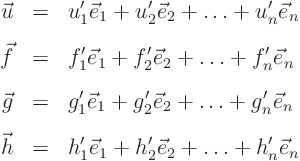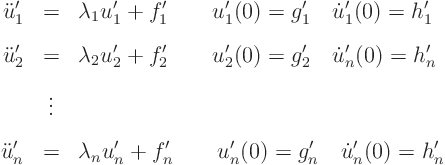|
|
|
|
|
Next: 17.2 Solving Partial Differential Equations |
|
You should know by now how to solve a system of ordinary differential
equations of the form
However, suppose that ![]() would be replaced by the
second order derivative
would be replaced by the
second order derivative ![]() ? Like in
? Like in
Of course, you can convert the above system to a double-size first
order one. But suppose you want to keep the system size the same?
Well, you can solve the system directly using the basis of
eigenvectors of matrix ![]() , assuming it is not defective. And the
relevant matrix A is typically a real symmetric one in these
applications, so never defective.
, assuming it is not defective. And the
relevant matrix A is typically a real symmetric one in these
applications, so never defective.
I will now show how the solution procedure works. First of course you
must find the eigenvalues and eigenvectors of ![]() :
:

Next you write every vector in the problem in terms of the eigenvectors:

You will need to figure out what the coefficients of the given vectors
![]() and
and ![]() are now. Note that the above equations can
be written in matrix form as
are now. Note that the above equations can
be written in matrix form as

Next remember that in the basis of the eigenvectors, matrix ![]() becomes a diagonal one, with diagonal values equal to the eigenvalues.
Therefore the original system of ordinary differential equations
simplifies to decoupled equations:
becomes a diagonal one, with diagonal values equal to the eigenvalues.
Therefore the original system of ordinary differential equations
simplifies to decoupled equations:

Finally you can find the solution vector ![]() at any desired time
by summing:
at any desired time
by summing:

Of course, you could also solve the first order system that
way. Compared to the class procedure, that has one big advantage. In
the class procedure, we solved a system of equations for the variation
of parameters, and one for the initial conditions. In the above
method, the matrix of the two systems of equations to solve is the
same, ![]() , so you can use a single augmented matrix with two right
hand sides (being
, so you can use a single augmented matrix with two right
hand sides (being ![]() and
and ![]() ). (And if
). (And if ![]() is symmetric.
it is easier still, because you only need to multiply by
is symmetric.
it is easier still, because you only need to multiply by ![]() .)
.)